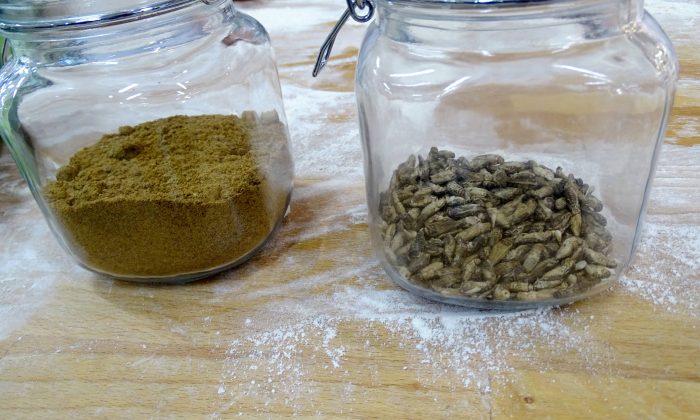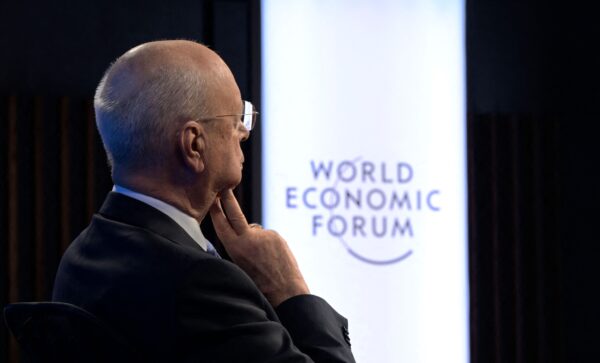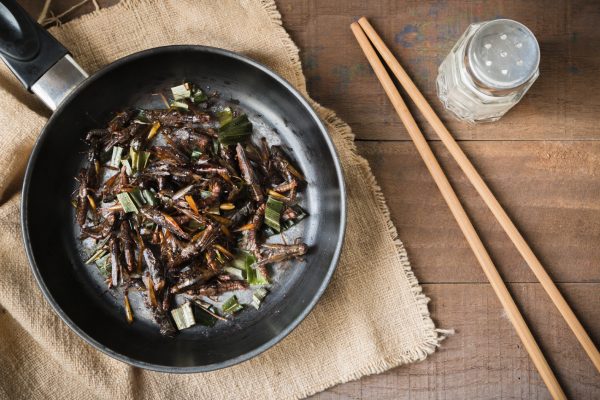
Whether roasted, dried, dipped in chocolate, or tossed into a smoothie, edible insects remain a tough sell for die-hard meat-lovers in Western countries.
Slowly but steadily, however, food products containing insect ingredients are finding their way onto supermarket shelves and online stores.
Most people probably don’t even notice products like Chocolate Chirp Muffin Bites, Hi! cricket protein bars or Actually Foods’ cheddar cheese puffs made with cricket powder.
“We do see an increase [in sales], and that’s due to educating people,” said Monica Martinez, founder, and CEO of Don Bugito, maker of “tasty edible insect snacks” in San Mateo, California.
 Founder and executive chairman of the World Economic Forum (WEF) Klaus Schwab is seen at the opening of the WEF Davos Agenda in Cologny near Geneva on Jan. 17, 2022. (Fabrice Coffrini/AFP via Getty Images)
Founder and executive chairman of the World Economic Forum (WEF) Klaus Schwab is seen at the opening of the WEF Davos Agenda in Cologny near Geneva on Jan. 17, 2022. (Fabrice Coffrini/AFP via Getty Images)
Martinez started the business in 2011 to create a more sustainable source of alternative protein for a healthier planet.
Today, her small business operates with six employees and serves a growing base of 500 customers through her physical store and online sales.
Her products include Chocolate Covered Crickets with Amaranth Seeds, Chile-Lime Crickets with Pumpkin Seeds, Coconut Brittle Bugitos, toasted crickets and other items.
Martinez said Don Bugito’s clientele has grown considerably since she started as one of the first edible cricket companies in the United States. Most of her customers are younger, environmentally conscious, and possess higher education.
“We have seen so many edible insect businesses come up and then die. We do see an increase [in sales], and that’s due to educating people. There has been a lot of work,” Martinez told The Epoch Times.
She said 10 years ago most Americans had no idea they could eat insects and enjoy the experience. While an estimated 2 billion people in Asia and Africa consume insects daily, change in culinary patterns comes slowly to Western countries, Martinez said.
Eating Bugs to Save the Planet
“There’s been a lot of gain [in popularity], but I won’t say the market is booming because it’s not. The majority of the public don’t care about what sustainability means or what climate change means.”
In February 2021, Time magazine ran an article on how humans eating insects would “save the planet.”
A month earlier, the World Economic Forum, an international organization of wealthy individuals headed by Klaus Schwab, released a video promoting insects as the future Western diet.
In a 2018 article titled “Good grub: why we might be eating insects soon,” the WEF predicted that billions of people would eat “creepy crawlies” regularly.
 Fried grasshopper with pandan seasoning and salt, pepper and soy sauce. (Kidsada Manchinda/iStock)
Fried grasshopper with pandan seasoning and salt, pepper and soy sauce. (Kidsada Manchinda/iStock)
According to the WEF, market analyst Meticulous Research projected that the global market for edible insects could triple to $1.18 billion by 2023.
The European Union’s Food Safety Authority also recently approved edible insects for sale in grocery stores and supermarkets.
At Euroccrickets, a cricket flour producer based in Lithuania, spokeswoman Kristina Macianskyte said that despite crickets’ nutritional and energy benefits, raising edible crickets has a very short production cycle compared with other protein sources.
“In just over a month’s time, we can grow a batch of a raw material that is extremely valuable in terms of its nutritional value,” Macianskyte said. “And the resulting raw material is 100 percent consumed.”
“We consumed 100 percent of what we create. And it’s all-natural.”
From a nutritional perspective, cricket flour is extremely rich in protein (about 65 percent), and contains essential trace elements, vitamins A, B12, D3 and fatty acids, Macianskyte told The Epoch Times.
“The insect is one of the few organisms on Earth that perfectly combines animal protein with dietary fiber. Omega-3 fatty acids are higher than in salmon; calcium is higher than in milk, and iron is higher than in spinach, and it’s rich in chitin.
“And all this is contained in 100 tasty and crunchy grams, fragrant with roasted sunflower seeds and nuts.”
In Canada, elementary schools have gradually introduced pupils to edible insects like flavored “cricket chips” to overcome their cultural aversion to eating insects.
If cricket chips aren’t your thing, you can order “Chocolate Chirp Cookies” at Hoppy Planet Foods. Each cookie contains three grams of cricket protein, 15 grams of carbohydrates, nine grams of sugar, and six grams of fat.
Then there’s Judee’s Confidence From Scratch, established in 2009, which sells gluten-free cricket flour that you can use with shakes, smoothies, or salad dressings, for an “extra source of protein.”
KickersCrickets.com is another company selling edible insect products, including Mini-Kickers—roasted cricket snacks in a test tube-like container in Mango Habanero, Italian Lasagna, Orange Creamsicle, Mexican Mole, and other flavors.
Old Dietary Habits Die Hard
The company also sells edible cricket powder, asking consumers, “Do you find it hard to eat a bug? Cricket powder is the answer.”
Retail giant Walmart is another place to find edible insect products such as cricket brownie mix and natural whole roasted crickets by Bud’s Cricket Power.
However, the notion that insects will be prominent in the global food pyramid could still be a ways off.
“The habit of consumerism certainly does not change in a day,” Macianskyte said.
“However, it is certainly likely that, just as shrimps and other seafood once supplemented the diet of all of us, so too will the insect find its place in our kitchens, not only adding to our healthy diets, but also conserving nature and its resources.”
Martinez said many edible insect startup companies in the United States don’t survive the challenges.
“My take is some of them are innovative and trendy and think they’ll make money. In most companies we see, a lot of young people jump in and think they’re going to fix the world.”
Many drop out when they realize it’s a dog-eat-dog economy in many ways.
“One of the challenges we faced was it’s expensive” to produce food made with edible insects, Martinez added.
She solved her production-cost problem using better efficiencies. Now, she sells products made with high-grade crickets and mealworms through a more sustainable business model.
Like Eurocrcrickets, Martinez sees edible insects as an a supplemental food source, and not a replacement for traditional protein like beef and poultry.
“It will never replace it unless there’s a global catastrophe. I don’t think people will stop eating beef or conventional proteins,” but the benefits of eating insects are “outstanding,” Martinez said.